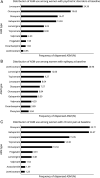Utilization of Antiseizure Medications in Women of Childbearing Age With Epilepsy and Nonepilepsy Indications: A Retrospective Cohort Study
- PMID: 37407266
- PMCID: PMC10491435
- DOI: 10.1212/WNL.0000000000207580
Utilization of Antiseizure Medications in Women of Childbearing Age With Epilepsy and Nonepilepsy Indications: A Retrospective Cohort Study
Abstract
Background and objectives: Antiseizure medications (ASMs) are among the most commonly prescribed teratogenic drugs in women of childbearing age. Limited data exist on utilization patterns across different indications for therapy and for the newer-generation ASMs in this population. Thus, we assessed the pattern of ASM use in women of childbearing age with epilepsy and nonepilepsy indications (pain and psychiatric disorders).
Methods: We conducted a retrospective analysis of deidentified administrative data submitted to the Optum Clinformatics database. Eligible participants included women aged 12-50 years who filled ASMs between year 2011 and 2017. Participants were followed from date of index prescription filled to study end or insurance disenrollment, whichever came first. For the overall cohort and potential therapy indications, we assessed the type and frequency of ASMs filled; proportion of participants on monotherapy, polytherapy, or treatment switching; and duration of continuous use. Trends were characterized using annual percent change from study start to study end.
Results: Our analysis included 465,131 participants who filled 603,916 distinct ASM prescriptions. At baseline, most of the participants had chronic pain (51.0%) and psychiatric disorders (32.7%), with epilepsy the least common (0.9%). The most frequently dispensed were diazepam (24.3%), lorazepam (20.1%), gabapentin (17.4%), clonazepam (12.7%), topiramate (11.3%), and lamotrigine (4.6%). Significant linear increase in trends were observed with gabapentin (annual percent change [95% CI]: 8.4 [7.3-9.4]; p < 0.001) and levetiracetam (3.4 [0.7-6.2]; p = 0.022) and decreasing trends for diazepam (-3.5 [-2.4 to 4.5]; p < 0.001) and clonazepam (-3.4 [-2.3 to 4.5]; p = 0.001). No significant change in trend was observed with valproate (-0.4 [-2.7 to 1.9]; p = 0.651), while nonlinear changes in trends were observed with lorazepam, topiramate, lamotrigine, and pregabalin.
Discussion: Decreasing trends were observed with older ASMs in the overall cohort and across the potential indications for therapy. Conversely, increasing trends were seen with the newer ASMs. Considering the risk of teratogenicity associated with the newer medications largely unknown, counseling and education in addition to a careful consideration of the benefits vs potential risks should remain pivotal when prescribing ASMs for women of childbearing age.
© 2023 American Academy of Neurology.
Conflict of interest statement
O.D. Lawal reports no disclosures relevant to the manuscript. K.J. Meador has received research support from the NIH and Sunovion Pharmaceuticals and travel support from Eisai and the Epilepsy Study Consortium pays his university for his research consultant time related to Eisai, GW Pharmaceuticals, NeuroPace, Novartis, Supernus, Upsher-Smith Laboratories, and UCB Pharma. A.L. Hume and X. Wen report no disclosures relevant to the manuscript. Go to
Figures



References
Publication types
MeSH terms
Substances
Grants and funding
LinkOut - more resources
Full Text Sources
Medical
